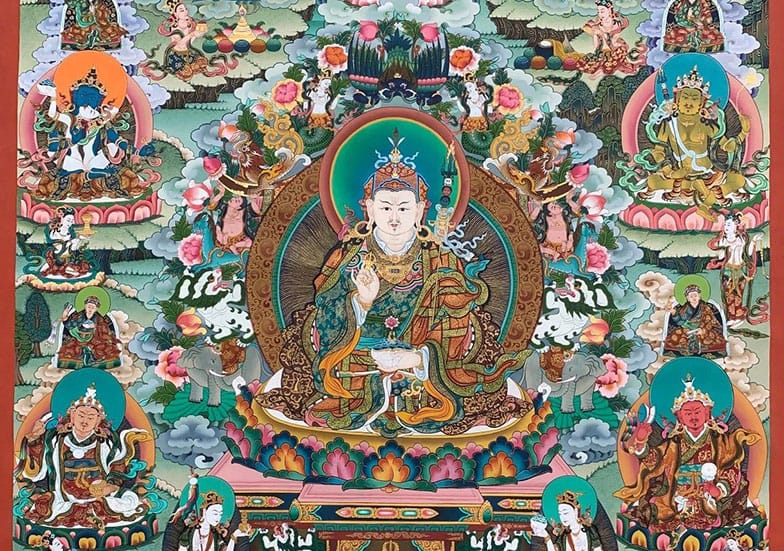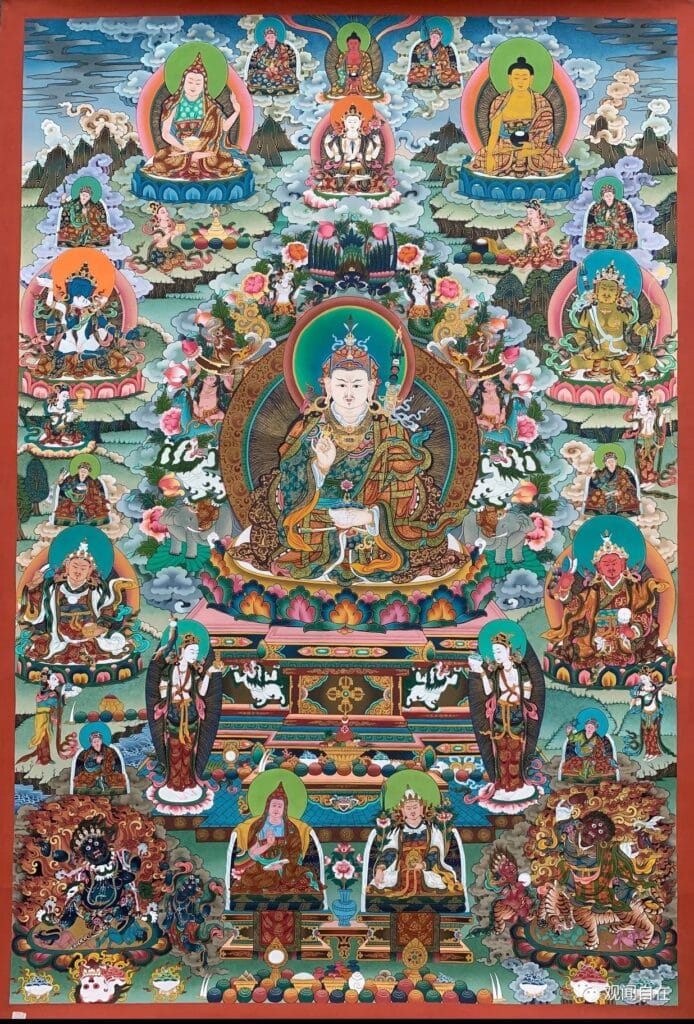
The Eight Transformations of Guru Rinpoche
Our vision is to preserve and pass on
One of the highest practices of Buddhism
The Inheritance and Teachings of Dzogchen

Guru Padmasambhava is the essence of all Buddhas of the ten directions and three times, and is the supreme protector that all sentient beings can rely on. In order to save all sentient beings, Guru Padmasambhava manifested one body, eight transformations, twenty magical changes, and other incredible illusions in Jambudvīpa to spread Buddhism. The eight transformations are the Sea-born Vajra, the Sakya Lion, the Lotus King, Pema Sangbawa, the Love and Wisdom Guru, the Sunlight Guru, the Wrathful Guru, and the Lion’s Roar Guru, which are called the Eight Transformations of Guru Padmasambhava.
1. Sea-born Vajra
Initially, the word “renunciation” in the heart of Amitabha Buddha was projected onto the lotus of the sea of Ugyen Danagosa, and an eight-year-old boy was born from the lotus core. This was Guru Rinpoche. King Enzabuddha of Ugyen had no children. Because he was kind and generous and often offered sacrifices to the Three Jewels, the treasury was empty, so he went to the sea to get treasures. On the way back, the minister Zi Namu Zha first saw the boy born in the lotus, and then the king also saw him. He had great faith in him and invited him to the palace as the prince, and named him “Sea-born Vajra”.
2. Wrathful Guru Rinpoche
Guru Rinpoche subdued the son of a treacherous minister, and the king exiled him to a charnel ground. In different charnel grounds, he preached various special Dharmas to people and non-humans who were predestined with him. He subdued all the ghosts and gods who had evil views on the Dharma without any predestined relationship with him in the form of Wrathful Guru Rinpoche, so he was called Wrathful Guru Rinpoche.
3. Sakya Lion
At the Vajrasana in India, Guru Rinpoche demonstrated various supernatural powers and said that he was a self-born Buddha. Many people did not believe him and slandered him. In order to lead these sentient beings to the path of liberation, he became a monk under the guidance of Guru Zabahari and was called Sakya Lion at that time.
4. Guru Padmasambhava of Love and Wisdom Guru Padmasambhava of Love and Wisdom received many exoteric and esoteric teachings, mainly Dzogchen, from many masters, including Xiri Sangha and Sangji Sangwa (Fo Mi). He could understand any sutra and tantra he heard, and he was able to understand them clearly and without hindrance, so he was called Luodan Chodze, which is translated into Chinese as “Love and Wisdom”.
5. Pema Sangbawa Guru Rinpoche performed various miracles in the kingdom of Saho. The king did not recognize his achievements and ordered people to pile up firewood and burn him. As a result, the fire turned into a lake, the firewood turned into a lotus, and Guru Rinpoche sat on the lotus with a bone garland hanging around his neck for dignity. He was not injured at all. At this time, he was called Pema Sangbawa
6. Padma King
King Saho and his ministers developed great faith in Guru Padma and asked him to serve as the king’s teacher for 13 years. They also took out precious clothes and lotus hats from the treasury as offerings. Guru Padma wore the lotus hat and was called Banma Gyalpo, which means Padma King.
7. Guru Rinpoche of the Sunlight
In the charnel ground of Gerazo, Guru Rinpoche demonstrated various abstinence practices and taught the tantric methods to the dakinis. He also subdued some ghosts and gods, preached many wonderful methods to them, and displayed various miracles in the sunlight, so he was called Ge Ri Nyingma Wo Re, which means Guru Rinpoche of the Sunlight.
8. Lion-roaring Guru Padmasambhava
In India, Guru Padmasambhava defeated five hundred heretics with wrong views in a debate and subdued them with the power of his spells, making them surrender and convert to Buddhism. At this time, he was called Ge Ri Sang Ge Zha Zhou, which means Lion-roaring Guru Padmasambhava.